Differential α-adrenergic modulation of rapid onset vasodilatation along resistance networks of skeletal muscle in old versus young mice
- PMID: 27501249
- PMCID: PMC5134404
- DOI: 10.1113/JP272409
Differential α-adrenergic modulation of rapid onset vasodilatation along resistance networks of skeletal muscle in old versus young mice
Abstract
Key points: Rapid onset vasodilatation (ROV) initiates functional hyperaemia upon skeletal muscle contraction and is attenuated during ageing via α-adrenoreceptor (αAR) stimulation, but it is unknown where this effect predominates in resistance networks. In gluteus maximus muscles of young (4 months) and old (24 months) male C57BL/6 mice, tetanic contraction while observing feed arteries and arterioles initiated ROV, which increased with contraction duration, peaked later in upstream versus downstream vessel branches and was attenuated throughout networks with advanced age. With no effect on muscle force production, inhibiting αARs improved ROV in old mice while activating αARs attenuated ROV in young mice. Modulating ROV through αARs was greater in upstream feed arteries and arterioles compared to downstream arterioles, with α2 ARs more effective than α1 ARs. ROV is coordinated along resistance networks and modulated differentially between young and old mice via αARs; with advanced age, attenuated dilatation of upstream branches will restrict muscle blood flow.
Abstract: Rapid onset vasodilatation (ROV) in skeletal muscle is attenuated during advanced age via α-adrenoreceptor (αAR) activation, but it is unknown where such effects predominate in the resistance vasculature. Studying the gluteus maximus muscle (GM) of anaesthetized young (4 months) and old (24 months) male C57BL/6 mice, we tested the hypothesis that attenuation of ROV during advanced age is most effective in proximal branches of microvascular resistance networks. Diameters of a feed artery (FA) and first- (1A), second- (2A) and third- (3A) order arterioles were studied in response to single tetanic contractions (100 Hz, 100-1000 ms). ROV began within 1 s and peaked sooner in 2A and 3A (∼3 s) than in 1A or FA (∼4 s). Relative amplitudes of dilatation increased with contraction duration and with vessel branch order (FA<1A<2A<3A). In old mice, attenuation of ROV was greater in FA and 1A compared to 2A and 3A. With no effect on muscle force production, inhibiting αARs (phentolamine; 10-6 m) improved ROV in FA and 1A of old mice while subthreshold stimulation of αARs in young mice (noradrenaline; 10-9 m) depressed ROV most effectively in FA and 1A. In young mice, stimulating α1 ARs (phenylephrine; 10-7 m) and α2 ARs (UK 14304; 10-7 m) attenuated ROV primarily in FA. In old mice, inhibiting α2 ARs (rauwolscine; 10-7 m) restored ROV more effectively in FA and 1A than did inhibiting α1 ARs (prazosin; 10-8 m). We conclude that, with temporal and spatial coordination along resistance networks, attenuation of ROV with advanced age is most effective in proximal branches via constitutive activation of α2 ARs.
Keywords: adrenoreceptors; ageing; blood flow; functional sympatholysis; microcirculation.
© 2016 The Authors. The Journal of Physiology © 2016 The Physiological Society.
Figures
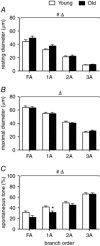
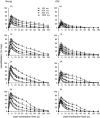
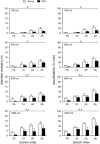
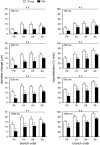


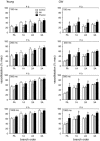

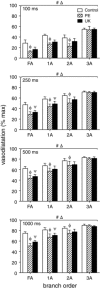
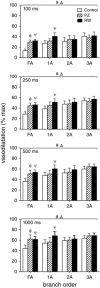
Similar articles
-
Rapid versus slow ascending vasodilatation: intercellular conduction versus flow-mediated signalling with tetanic versus rhythmic muscle contractions.J Physiol. 2017 Dec 1;595(23):7149-7165. doi: 10.1113/JP275186. Epub 2017 Nov 9. J Physiol. 2017. PMID: 28981145 Free PMC article.
-
Blunting of rapid onset vasodilatation and blood flow restriction in arterioles of exercising skeletal muscle with ageing in male mice.J Physiol. 2010 Jun 15;588(Pt 12):2269-82. doi: 10.1113/jphysiol.2010.189811. Epub 2010 Apr 7. J Physiol. 2010. PMID: 20375140 Free PMC article.
-
Aging alters reactivity of microvascular resistance networks in mouse gluteus maximus muscle.Am J Physiol Heart Circ Physiol. 2014 Sep 15;307(6):H830-9. doi: 10.1152/ajpheart.00368.2014. Epub 2014 Jul 11. Am J Physiol Heart Circ Physiol. 2014. PMID: 25015968 Free PMC article.
-
Microvascular mechanisms limiting skeletal muscle blood flow with advancing age.J Appl Physiol (1985). 2018 Dec 1;125(6):1851-1859. doi: 10.1152/japplphysiol.00113.2018. Epub 2018 Nov 9. J Appl Physiol (1985). 2018. PMID: 30412030 Free PMC article. Review.
-
Effect of aging on the structure and function of skeletal muscle microvascular networks.Microcirculation. 2006 Jun;13(4):279-88. doi: 10.1080/10739680600618892. Microcirculation. 2006. PMID: 16611595 Review.
Cited by
-
Sympathetic nervous system activation reduces contraction-induced rapid vasodilation in the leg of humans independent of age.J Appl Physiol (1985). 2017 Jul 1;123(1):106-115. doi: 10.1152/japplphysiol.00005.2017. Epub 2017 Apr 6. J Appl Physiol (1985). 2017. PMID: 28385914 Free PMC article.
-
Stimulation history affects vasomotor responses in rat mesenteric arterioles.Pflugers Arch. 2019 Feb;471(2):271-283. doi: 10.1007/s00424-018-2206-0. Epub 2018 Sep 15. Pflugers Arch. 2019. PMID: 30219946
-
TRPV1 in arteries enables a rapid myogenic tone.J Physiol. 2022 Apr;600(7):1651-1666. doi: 10.1113/JP281873. Epub 2022 Feb 1. J Physiol. 2022. PMID: 35020949 Free PMC article.
-
Calcium and electrical signaling in arterial endothelial tubes: New insights into cellular physiology and cardiovascular function.Microcirculation. 2017 Apr;24(3):10.1111/micc.12328. doi: 10.1111/micc.12328. Microcirculation. 2017. PMID: 27801542 Free PMC article. Review.
-
Recovery of blood flow regulation in microvascular resistance networks during regeneration of mouse gluteus maximus muscle.J Physiol. 2019 Mar;597(5):1401-1417. doi: 10.1113/JP277247. Epub 2019 Feb 3. J Physiol. 2019. PMID: 30575953 Free PMC article.
References
-
- Beach JM, McGahren ED & Duling BR (1998). Capillaries and arterioles are electrically coupled in hamster cheek pouch. Am J Physiol Heart Circ Physiol 275, H1489–H1496. - PubMed
Publication types
MeSH terms
Substances
Grants and funding
LinkOut - more resources
Full Text Sources
Other Literature Sources
Medical

